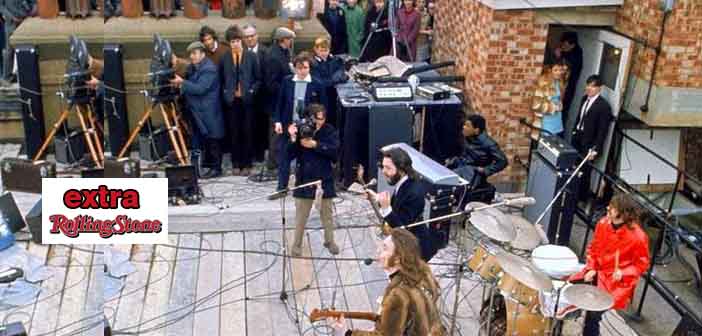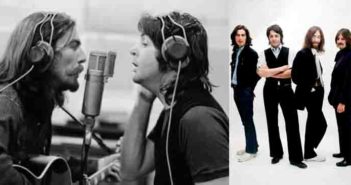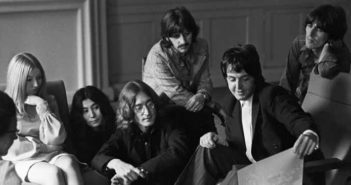Some backstage and tips from the roof top concert 30th Juanary 1969.
The Beatles' rooftop concert was the climax of a project originally titled Get Back. It was conceived as exactly that, a return to their rock roots in a desperate effort to restore unity when business and personal chaos threatened to destroy the band. A documentary crew filmed the Beatles rehearsing and recording new material for an "honest" album, free from the studio wizardry that had dominated their recent work. The experience pushed the group to the point of disintegration, but they needed an end to the film.
The film which was originally planned as a television documentary features an unannounced rooftop concert by the group, their last performance in public. Released just after the album, it was the final original Beatles release.March 1970 – The LP release in UK was Today, 8th May 1970
Let it Be The film, which was shot in January 1969, was originally intended to be a TV special called Get Back featuring the group rehearsing for their first live show in over two years.
The Beatles Let It Be Film (outtakes, camera A).
Full article here:http://www.rollingstone.com/music/news/beatles-famous-rooftop-concert-15-things-you-didnt-know-20160129
So 47 years ago — on January 30th, 1969 — the band climbed five stories to the top of their Apple Corps headquarters and played their last concert together. The album and film were ultimately released in May 1970 as Let It Be, their swan song. Here are 15 little-known facts about the Beatles' final bow on the world stage.
The concert was originally going to take place in an ancient amphitheater. Or on a cruise ship. Or in the desert.
The Beatles had many ideas about where to perform the climactic concert for their new film — too many ideas. London venues like the Palladium and the Roundhouse were some of the more levelheaded propositions, but most were pretty far-out. The Sahara desert was floated as a potential location, as were the Giza pyramids, and even the QE2 ocean liner. A 2,000-year-old Roman amphitheater in Tunisia was seriously considered, and location scouts were sent to investigate. "The Beatles were to start playing as the sun came up," explained director Michael Lindsay-Hogg, "and you'd see crowds flocking towards them through the day."
Billy Preston recalls that it was John Lennon who had the idea to stage the concert on the roof of Apple headquarters. Lindsay-Hogg says it was his idea. Others attribute it to Ringo Starr. The concept sounds inspired, but in retrospect it speaks less to creativity and more to laziness.
A few minutes before the concert was due to start, the band huddled in a small vestibule at the top of the stairs. They had cold feet. "George didn't want to do it, and Ringo started saying he didn't really see the point," says Lindsay-Hogg. "Then John said, 'Oh, fuck it — let's do it.'"
Jefferson Airplane performed on a New York City rooftop several weeks earlier.
The film is directed by the secret son of Orson Welles — allegedly.
Having worked with the Beatles on their recent promotional videos for "Hey Jude" and "Revolution," American filmmaker Lindsay-Hogg was the logical choice to direct the Get Back project. He arranged an army of cameras to capture the moment from all angles, sending a crew into the street, the adjacent building, and the Apple reception area — not to mention the five cameras on the roof itself. The result is some of the most iconic concert footage in history.
Lennon and Starr wore their ladies' coats.
It was 45 degrees in London that raw January afternoon, and that doesn't account for the icy wind whipping over the West End buildings. Impending fog had ruled out an expensive helicopter aerial shot, and the threat of rain was very real. These conditions were not ideal to making rock and roll. "[My] hands [are] too cold to play the chords," Lennon muttered between songs, and Apple Corps exec Ken Mansfield held a constant stream of lit cigarettes so George Harrison could warm his fingertips. To ward off the winter chill, Lennon borrowed Yoko Ono's fur coat (as he did on occasion). Ringo Starr also donned his wife Maureen's red raincoat.
The microphones were wrapped in women's pantyhose.
The cold gusts also proved to be a problem for the delicate studio microphones recording the drums and guitar amplifiers. In need of a quick shield to minimize wind noise, tape engineer (and future Pink Floyd cohort) Alan Parsons was dispatched that morning to buy women's pantyhose. "I walked into this department store and said, 'I need three pairs of pantyhose. It doesn't matter what size.'" he recalled in Guitar Player. "They thought I was either a bank robber or a cross-dresser."
George Harrison's guitar was the first of its kind.
The Telecaster that Harrison played throughout the rooftop concert was custom made for him by master builders Roger Rossmeisl and Philip Kubicki as a gift from Fender. The company was launching a new line of all-rosewood guitars, and presenting the prototype to a Beatle was good publicity. After many hours of labor, the guitar was flown to England in its own seat and hand-delivered to Apple headquarters. The builders weren't sure what became of the guitar for over a year, until they bought tickets to see the Let It Be film and saw their handiwork on the big screen. "I was so thrilled I almost jumped out of my seat," remembers Kubicki.
John Lennon needed cue cards to remember his own lyrics.
John Lennon always had a problem with lyrics. Paul McCartney often recalls seeing Lennon onstage singing his own ad-libbed words to the Del Vikings' "Come Go With Me" on the day they met in 1957. Wanting to get things reasonably correct for the film, the Beatles asked Apple office assistant Kevin Harrington to kneel just out of camera view and hold up a lyric sheet for "Dig a Pony." Lennon still managed a memorable flub during "Don't Let Me Down," singing something like, "And only reese we got the blootchy-koo."
"One After 909 " is one of the earliest Lennon-McCartney compositions the Beatles released.
"It's not a great song," McCartney remembered in later years. "But it's a great favorite of mine because it has great memories for me of John and I trying to write a bluesy freight-train song."
The band had originally recorded "One After 909" at EMI Studios during sessions for "From Me to You" in March 1963. This version was shelved, but the song was resurrected six years later for the Get Back/Let It Be project — as a joke more than anything else. The live version from the rooftop concert ended up on Let It Be, giving "One After 909" its long-awaited public debut on the last album they issued.
There were other songs performed on the rooftop that day.
While 21 minutes of the concert made it into the final Let It Be film, the actual performance was twice as long. During the 42-minute set, the Beatles played "One After 909," two complete versions each of "Don't Let Me Down," "Dig a Pony" and "I've Got a Feeling," and three versions of "Get Back" — plus various incomplete takes, including a line from the Irish folk song "Danny Boy."
In addition to these, the band tossed off snippets of several songs that didn't make the cut for Let It Be. These include a few bars of "I Want You," later released on Abbey Road, and lines from the Irving Berlin chestnut "A Pretty Girl Is Like a Melody." The most complete of these off-the-cuff performances is an instrumental version of "God Save the Queen," played while engineer Alan Parsons changed tape reels. These were little more than jokes, and were never seriously considered for any official release.
The police weren't as bad as they've been made out to be.
Beatles lore portrays the London Metropolitan Police as the prototypical blue meanies who forcibly halted one of the greatest musical moments of the 1960s. To a certain extent, this is true. But the bobbies actually cut the band some slack — and did them a serious solid.
The West End Central Police Station is located at 27 Savile Row — mere feet from Apple headquarters. The authorities obviously must have heard the loud rock music wafting down the street. Windows rattled, floors shook, and horns blared from the resulting traffic jams. If they wanted to, the police could have walked over and shut things down before the first song was over. Instead, they let the concert continue for 42 minutes. It was only when the noise complaints began to flood in from stuffy local businesses that they felt compelled to act.
Even then, they gave the Beatles and Co. ample warning to get rid of certain illicit substances that might have been on the scene. "Before the raid, someone called from the Savile Row police station saying, 'You've got 10 minutes.'" recalled one Apple employee. "So we knew they were coming and everyone was ready for it. ... When the police raided the building, there was a whole chorus of toilets being flushed." Crisis averted.
Preston's sparking musical contribution on Let It Be speaks for itself. Lennon even lobbied to make Preston a full member of the band — an actual fifth Beatle. "It's bad enough with four!" McCartney supposedly replied. Even so, his importance was recognized on the single release of "Get Back," which is credited to "The Beatles with Billy Preston." Barring unauthorized reissues, it was the first time that the Beatles credited anyone on their records in this way.
Preston would go on to record with the Beatles on Abbey Road that summer, laying down keyboard parts on "I Want You (She's So Heavy)" and "Something."
The site of the rooftop concert is now a children's Abercrombie & Fitch.
The Beatles purchased 3 Savile Row in 1968 as the headquarters for Apple Corps. They constructed a studio in the basement, which they used to record the second half of their Get Back/Let It Be sessions. Harry Nilsson, Badfinger, Marc Bolan and others also recorded there before Apple sold the building in 1976. It changed hands a number of times over the years until it was purchased by Abercrombie & Fitch in 2012. A children's clothing store currently resides in the building's ground floor — throwing London tailors, historians and Beatle fans into an uproar.
















